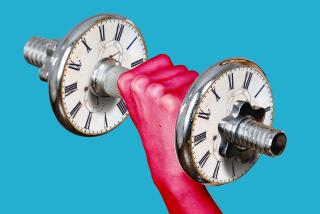If They Had Been Active, the Mighty Might Not Have Fallen
Serious falls among older adults are often considered a consequence of failing eyesight and disability. But public health experts say such falls are frequently the result of a sedentary lifestyle that weakens the body and that exercise programs--such as dancing, tai chi and strength training--may be the best way to curb an alarming rise in serious falls.
One in three people 65 and older falls, notes Judy Stevens, an epidemiologist at the National Center for Injury Prevention and Control in Atlanta. âFalls are a result of a personâs physical condition and their environment,â she says. While itâs important to make living areas safer--by removing tripping hazards and installing grab bars, for example--Stevens says environmental improvements are only part of the picture.
A fall is generally the product of a constellation of factors, including household clutter, the disorienting effects of some medications and poor vision. In addition, people are living longer, often with some form of disability. But a major reason for falls, Stevens says, is older adultsâ weakened physical condition, frequently as a result of inactivity.
A recent report from the center reveals that the fall-related death rate among people 65 or older increased by about 27% among women and by almost 19% among men between 1987 and 1996. The rate of hospitalizations for hip fractures jumped by almost 40% among women between 1988 to 1996.
âVarious research projects are looking for ways to prevent falls,â Stevens says. âThe most effective intervention we have found so far is exercise. Programs that concentrate on improving strength and balance appear to make the biggest difference.â
The best-researched exercise to prevent falls is the Chinese art of tai chi, notes Stevens, who says the practice can reduce falls by as much as 50% in certain populations.
Even the familiar and enjoyable activity of dancing is gaining increased attention as a way to help healthy older adults improve balance and agility, says Mary Tinetti, chief of geriatrics at the Yale University School of Medicine.
âDancing can be culturally specific,â Tinetti says. âBallroom dancing, African dancing, folk dancing--it doesnât seem to matter. They all appear to help people know how to respond when their balance is challenged.â For frailer people, specific balance exercises can be helpful, says Tinetti, who recently developed a series of exercises that are taught by a physical therapist.
Researchers are also paying increasing attention to the benefits of strength training. Ben Hurley, a professor in the department of kinesiology at the University of Maryland, says it can help increase strength and power in muscle groups associated with falls, and may also improve walking mechanics and stability.
In addition, âstrength training helps prevent and treat a disease called sarcopenia, which is literally the loss of flesh with age,â Hurley says. Sarcopenia is associated with declines in daily functioning and also with metabolic changes, which may include impaired glucose tolerance and increased risk of diabetes.
âStrength levels decrease by about 12% to 14% per decade, starting at about age 60 in men and about age 50 in women,â says Hurley. Yet the decline in strength that occurs after two to three decades of aging--about a 30% to 40% loss--can be regained within the first two months of a properly designed strength-training program, he says.
âOlder people respond to strength training about the same as young people and probably achieve more health-related benefits than young people,â he says. âFor example, older individuals not only have lower strength and muscle mass than young people, but they also tend to have a lower resting metabolic rate, lower bone mineral density and are at higher risk for diabetes--all areas that can be improved with strength training.â
All these therapies are aimed at reducing sedentary lifestyles, which can contribute to frailty. âThree words are critical in helping people maintain their independence,â says Steven Wolf, a professor and director of research in the department of rehabilitation medicine at Emory University School of Medicine in Atlanta. âThey are: move, move, move.â
Yet âolder adults are the least physically active age groupâ in the United States, says David Buchner, chief of the physical activity and health branch of the federal Centers for Disease Control and Prevention in Atlanta. âForty-two percent of men over age 75 and 50% of women over age 75 are inactive.â
Inactivity can become a debilitating cycle, says Thomas P. Sculco, a New York orthopedic surgeon. âSome elderly people do less because theyâre afraid theyâre going to fall,â he says. âThen they get weaker because theyâre inactive, and they do fall.â
Physical-activity programs can help older people strengthen both body and mind, Sculco says. âExercise helps people get stronger and more confident,â he says. âThis can help them stay independent longer.â
(BEGIN TEXT OF INFOBOX / INFOGRAPHIC)
Educating the Public
These health organizations have launched public education campaigns about preventing falls:
* âPrevent Injuries America,â a new program from the American Academy of Orthopaedic Surgeons, offers a variety of free information, including the brochure âDonât Let a Fall Be Your Last Trip.â Call the group at (800) 824-BONE or visit the Web site at https://www.aaos.org.
* The National Institute on Aging offers a free, 100-page booklet on exercise for seniors and has just released a companion video that sells for $7. To receive both, mail a check or money order for $7, payable to the National Institute on Aging, to NIAIC, Department F, P.O. Box 8057, Gaithersburg, Md. 20898-8057. To receive only the free booklet, call (800) 222-2225.
* The Keiser Institute on Aging, the educational branch of the Fresno-based exercise equipment manufacturer, runs a yearly fall-prevention program, with materials such as a risk assessment test. For information, call (800) 888-7009.
* The National Osteoporosis Foundation offers a brochure with balance exercises and other fall-prevention strategies. For a free copy, write to NOF, Department FF, P.O. Box 96616, Washington, D.C. 20007-7456 or visit the Web site at https://www.nof.org.






